I’ve been asked why my historical garments don’t always look perfectly pressed in my photos.
There are five reasons for this (what a lovely coincidence, it means this works perfectly as Five for Friday):
First, my garments are made from fabrics that are as close to historically accurate as I can manage, which means they are made from natural fibres (silk, wool, cotton and linen), which don’t always press as crisply and smoothly and permanently as synthetic fabrics, nor stay as crisp and pressed. This makes them look rumpled, but its also part of their charm, and part of what we value them for.
Think of Princess Diana’s wedding dress, and how rumpled it looked as she got out of the carriage. If the woman about to become the Princess of Wales can’t have a perfectly pressed, non-rumpled dress out of certain silk fabrics, it’s not possible.
For an example of this, look at the photos that Mandi Lynn of A La Mode photography took for the Radio New Zealand photoshoot. I spent hours ironing and steaming every single layer of these frocks, they went straight from the steamer on to the models, and straight from there in front of the camera. The frocks are as perfectly and pristinely pressed as possible, and yet there is still a suggestion of rumples and wrinkles. It’s simply the nature of some fabrics, particularly silks.

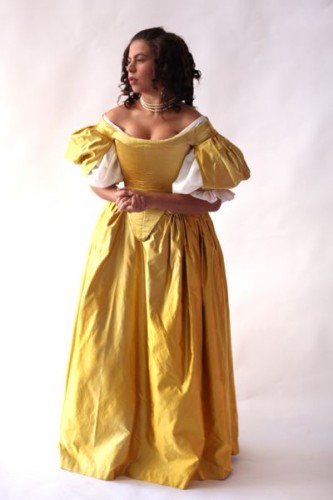
And here is Queen Victoria in her wedding dress by WInterhalter. Note the silk of her skirt, both smooth and rumpled:
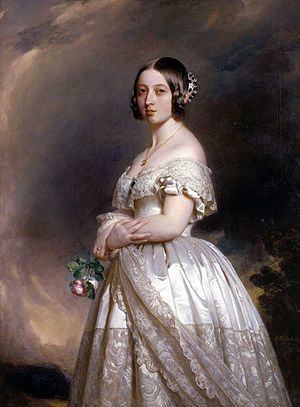
Second, by the time photos have been taken, my garments have usually been lived in and worn for a fair bit. They have been put on a model, often crammed into a car with as many other models in big dresses as can safely and legally fit in a car. If I’m wearing the dress, I’ve probably had to drive in it. Then they get sat in, moved about in, pressed against, etc. They stop looking absolutely pristine and freshly pressed.
I actually value the bits of wear that my costumes get: both the momentary wear of sitting creases, and the longer-term wear of dulling finishes and worn hems. It makes them look real, and lived in. Sometimes movie costumes look too perfect and freshly, and I’m not able to maintain the suspension of disbelief that makes the film believable and enjoyable.
There is plenty of historical evidence to support wear, tear, rumpling and crumpling happening in period. Women attending balls wrote of coming home with wilted ruffles, torn flounces, and a general state of dishevelment, and cartoons satirized the wear to clothes that happened at the crush of the royal court in England, with attendees arriving with feathers proud and frocks pristine, and leaving looking no better than the beggars who had lined the way there, hoping for a bit of largesse.
Here we are, all freshly pressed and dressed, taking tea, before a talk and photoshoot. By the time the talk and photoshoot happened a certain amount of sit creasing would inevitably have set in
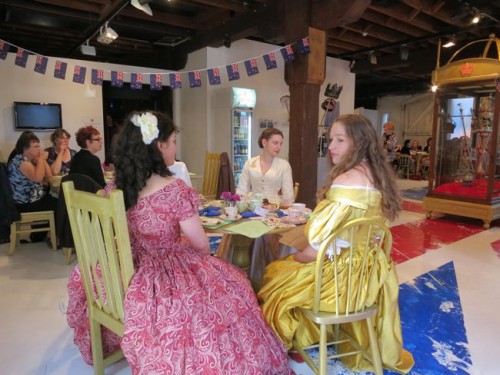
Third, sometimes I specifically want an un-pressed look for historical accuracy. There is both painted and photographic evidence that period frocks weren’t always perfectly pressed. Ironing was difficult and time consuming; not everyone had the time, equiptment and inclination. At certain periods, there was actually a cache attached to the crisp, square creases of a garment just removed from the dressmakers box, so garments were purposefully left unpressed.
Here is Charlotte Bonaparte, Napoleon I’s niece (and at one point his potential wife, though thankfully he decided such a marriage was a bit too squiggy (probably not in those words) and married someone he wasn’t related to instead) in a beautiful sky blue silk gown, with marked horizontal creases across the front of her gown. The creases are probably an indication that the gown was brand new, fresh out of the box and never worn – indicating both her family’s wealth, and probably also alluding to her youth and untouched status.

Portrait of Charlotte Christine Bonaparte (later Gabrielli), 1808, by Jean-Pierre Granger
As another example, here is a lovely late Victorian couple, posed in what may be their wedding finery with boutonnières and corsages. Her gorgeous silk satin skirt is puckered at the seams, has a badly finished hemline, and is quite creased, and yet, this was at a time when a posed studio photograph was still a momentous occasion.
Fourth, sometimes I just don’t press things.
I’m a busy woman. I run my own business, work over 8 hours a day 6 days a week, write an almost daily blog, sew, teach Baha’i children’s classes every fortnight, do other volunteer work, and manage to keep my house reasonably tidy, my husband and I reasonably well fed with home cooking, and some semblance of a personal and social life going.
My garments involve a lot of fabric, and a lot of pleating and gathering and trim which make ironing difficult. Ironing one of my outfits properly takes, on average, at least an hour. For a talk with 6 models and myself, that’s an entire work days worth of ironing (with teeny breaks for tea and lunch). And it has to be done very shortly before a garment is worn, which leaves me little time to deal with models getting sick, pouring rain requiring change of venues and alternate frocks, or any other emergencies.
For proper talks and photoshoots I usually manage it (with lots of help from the models and other volunteers), but when it is just for a personal event I often decide I’d rather spend an hour with Mr D, wash the dishes, have a nap, play with Felicity, etc, than iron a dress.
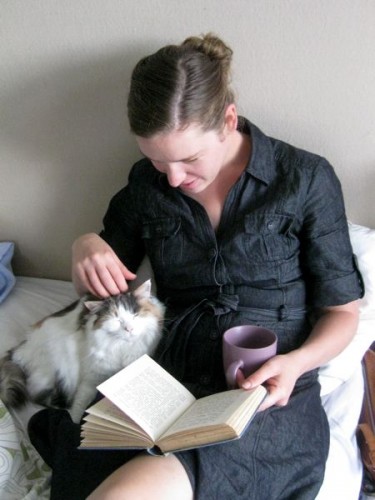
Sometimes Fiss and I just need to cuddle with a cup of tea and a good book
Finally, photography can seriously emphasise wrinkles and creases. A dress can look quite acceptable in person, with any creasing lost in the movement, but when you see a photograph of the same garment, the static pose and lighting make any creases glaringly obvious. Our 1890s woman in her silk skirt probably looked much less creased and rumpled in person.
For an example of this, lets look at pictures of my 1913 Carte Blanche dress at last years Aethercon ball. It had been an incredibly full-on and stressful day for me, I wasn’t sure if I was going to make the ball, the weather was terrible, and I wasn’t up to wearing the heavily corseted frock I’d meant to wear. Carte Blanche was a last minute solution, and I couldn’t be bothered ironing it. It’s also made from tussah silk, a very which means that even at its most freshly pressed, it looks slightly rumpled. Completely un-ironed, it was very creased, but different photographs make it look more or less creased:
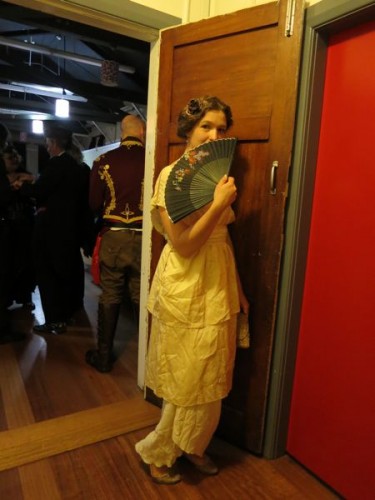
Un-ironed Carte Blanch dress seen with a flash – tons of wrinkles
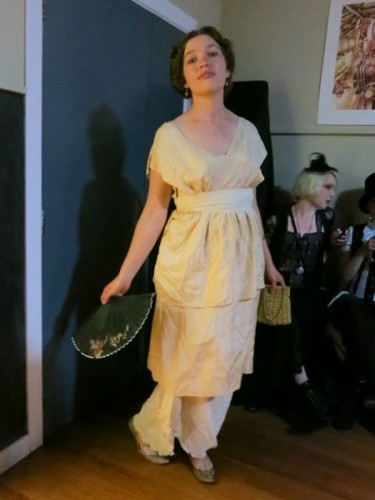
Un-ironed Carte Blanch dress seen without a flash – wrinkles are there, but less obvious
One day I’ll have lots and lots of space, and ideal storage situations so my dresses don’t crumple, and professional irons and steamers, and people other than me to do the ironing and steaming every single time, but for now, my dresses are going to have the occasional completely crumpled moment. Unless you want to come over and do the ironing for me? 😉


Dear Leimomi,
Lots of us do understand and empathize with both the naturalness of wrinkles and with having an enormously busy schedule but forging ahead anyhow.
Kudos to you for for taking up the subject.
At least you and your models didn’t cause wrinkles by wearing your corsets upside down, as I managed to do last Saturday evening (after yes, a very busy day with the family): http://zipzipinkspot.blogspot.com/2013/04/maam-your-corsets-on-upside-down.html.
Very best,
Natalie
Hehe. I’ve never put my corset on upside down, but I’ve had students and models do it all the time!
And thank you for commiserating with me on wrinkles and time crunches. I really respect your sewing, and your opinion, so your understanding means a lot!
Oh goodness! Many thanks! [blush]
Wrinkles are fine. I never notice them in daily wear, unless it is ridiculously and badly wrinkled and gives the appearance of being scrunched up and left on the floor to be trampled on until the next wearing (Yes, sometimes that happens to my clothes. Yes, I iron them before wearing them.).
Wrinkles that occur from wearing them as they are supposed to look natural to me, and while it’d be cool if all fabric only wrinkled when/where we needed it to, that’s impossible and hopefully everyone else out there realizes that, too. 😀
Just yesterday I wore a thin rayon shirt. It’s a very good quality one, too. It had just been ironed PERFECTLY, and there were absolutely no wrinkles anywhere. But a few minutes after putting it on and doing normal activities, it was pretty darn wrinkled. It’s just what happens.
And I always feel encouraged when I see people like you, whom I consider some of the best, most skilled and knowledgeable when it comes to historical clothing, confirming what I feel about wrinkles. 😀
Thanks Cheyene!
I’m a moderate presser in daily wear – I don’t do jeans and T-shirts, and have a few blouses I will wear slightly crumpled, and a few that, like your rayon, crumple as soon as I put them on anyway. Mostly though, I manage the 5 minutes it takes to press my modern clothes. It’s just the hour per outfit for historical I can’t always make happen!
Uhhh… people seriously have questioned why your dresses have wrinkles? What planet do they live on that they have no wrinkles, ever? Human beings move. Pff.
I guess you can have a social life or personal live, MAYBE. But really, you should be budgeting your tea time to accommodate more ironing. Because of reasons.
Personally I sort of cringe at the thought of historical ironing…heating up multiple irons on a fire, trying not to burn yourself or the clothes, and actually get a usable product? My eyes sort of went googly when I saw Lauren of American Duchess’s post about ironing/creating crinkly pleats. That is a LOT of work! The note about creases being fashionable — like recently bought — very interesting! It makes sense though.
Well, it was a bit cheeky, but it was a valid question, and gave me an excuse to talk about it, and to educate, so ultimately, I don’t mind.
I’d love to have a pleating press like Lauren – when I think of how often I burn myself with a regular iron when pleating, a historical heat-up one that does all the crimping for you actually seems like a safe and viable option!
Natural, lived-in wrinkles are one thing, & of course everyone has those. But there are unfortunately quite a few (hopefully beginning?) costumers who appear to have never introduced an iron near their clothing, & they post pictures of themselves in completely wrinkled costumes. I suspect it comes from the modern 21st-century lack of ironing in everyday life. Few ppl these days iron their clothes, everyone seems to buy garments that don’t need to be ironed, so the art & practice of ironing is lost even on those who sew.
But ironing fabric before one cuts is crucial, & ironing seams as one sews is hugely important to the final look of a garment. And, of course, ironing before actually wearing the outfit gives a polished appearance. Yep, natural fibers will wrinkle as you wear an outfit, but if you never ironed it at all, that will look worse.
Oh, ironing as you sew is COMPLETELY different than ironing once it is sewn up when you are really busy. I am fanatical about pressing fabric before sewing, and as I sew. I spend a lot of time telling my iron what a dreadful piece of crap it is, because it starts beeping if I leave it alone for more than 7 minutes. When I sew, it’s on all the time, and some seams take more than 7 minutes to pin and sew before I’m ready to press again.
I joke to my students that I lied to them, and they aren’t taking sewing classes, they are taking pressing classes because we spend as much time at the iron as on the sewing machine 😉
modehistorique.comI’ve actually found that in my experience, natural fibers press *better* than synthetics. They can withstand higher heat and certain fibers will hold a beautiful press. Wool in particular is great for not wrinkling, though that means it can be quite a challenge to get it to crease for sewing purposes!
Silk taffeta and satin definitely have a distinctive “rumple”, but creases from hanging, sitting, or this-dress-fell-off-its-hanger-and-bunched-on-the-floor-for-a-week press out really nicely. Although, I usually iron them at a setting higher than that recommended for silks on my iron. So far everything has been able to handle it fine–no scorching–and I get a lovely flat press.
Linen in particular presses gorgeously…you can finger-press it into creases, but if you’ve got a stubborn wrinkle you want to make disappear, you can spritz and iron it on volcano heat–it’s like magic! Cotton’s a little pickier, but spritzing or sprinkling usually does the trick for me.
Synthetics on the other hand have always been a bit evil for me. I’ve melted a few holes in my time, and I don’t think I was ever perfectly happy with how seams ironed while I was making the few polyester garments I attempted. That’s partly why I swore never to use them again…the other reason being how I felt like I was wearing a trash bag since they don’t breathe!
I really liked this post by Sarah Lorraine over at Mode Historique: http://www.modehistorique.com/blog/?p=1053 and the point she makes about a wrinkled gown not being a testament to a seamstress’ skills. I’ll be the first to admit that I don’t always treat my historical clothes as nicely as I ought–or my every-day clothes! But if something looks too horribly abused, a quick once-over with a hot iron generally makes me feel MUCH more confident that my work is being shown to its best advantage, and then at least I know I tried.
I have to completely agree with you Katie! Though wrinkles MAY be period correct in some cases, the unfortunate truth is that it is all people will ever see, and it detracts from the beauty that is your completed garment.
I have a slightly different take on this. As a historian I feel I have an obligation to present the truth, not what we, in the present, feel is attractive or beautiful. Otherwise we are just whitewashing history. When I do purposely present a garment with wrinkles, I mention it – it’s a good opportunity for learning, and for discussion about how long it took to maintain clothes in the past, and how standards change.
All sort of standards have changed from era to ear: what colours and shapes look good on different hair and skin tones and body shapes, what colours go together, what silhouettes are attractive. I can’t just study and present and talk about what is pretty to us.
I certainly don’t present a modern take on history if I can help it, either. Often my regency garments get a little rumpled when I pack them in my trunk to go to events, however; also keep in mind some garments are of a quality and a class that ironing was NOT intangible, so it is a very tricky line to tread. Some garments I would not mind leaving wrinkled, to represent the social class I am in, others – not as much. For example, my 18th century attire is meant to represent the American Frontier. How often do you think traveling from fort to fort would I have an opportunity to iron? Not nearly as much as I would living in the Capital. My early 19th century garments, however, I attempt to keep as nice as wearing will allow and often hang them when they are at home or fold them nicely just in half to prevent crinkles because I represent a significantly higher class than my 18th century garb – therefore I can afford to have a maid present to iron garments for me when requested. I do understand what goes into ironing garments in the era – I am quite well acquainted with a woman who demonstrates period laundry, and know that it wasn’t completely out of the question for upper class sorts, especially as the technology has improved to have nicely pressed clothes.
Sounds like you understand exactly what I am talking about 🙂
There are times (Regency era frontier dress) when a bit of rumpling is part of the picture, and doesn’t detract from the beauty of your garments, and when pressing wouldn’t be correct. And then there are times when upper class clothes should be pressed and perfect, and that is historically accurate.
Perhaps you can clarify something for me–I kind of got the idea that, for example, the courtiers emerging all rumpled was something that people satirized–mocked–and would therefore be undesirable. If, say, someone were portraying a courtier at a historic site (that’d be some site!) or for a museum, wouldn’t it be preferable for them to avoid rumpling their clothes (or at least attempt it), since I’m guessing the courtiers in the past probably didn’t appreciate having their flaws pointed out? Or would you say that if the interpreter *didn’t* have wrinkled clothing, that their interpretation was flawed or the museum’s education program sub-par?
Also, do you have any more information or sources on the creases of a boxed garment being desirable? That’s not something I’d heard before and I’d be interested to know what kinds of records mention something that seems rather subtle to a modern perspective.
Oh, absolutely, no one liked the mess they ended up in after a too-full court affair. I’m not saying that we should aim for that look from the start (though if I were doing a talk specifically on court dress, I might, out of 10 models, purposely have one ‘end of the event’ look), but that there is nothing wrong with arriving at that look at the end of a ball, and showing images of your outfit in that state, as I do. Wear did happen, and with the advent of cameras, people did get photographed looking like that in their commemorative presentation photographs. There is a wonderful set of studio photographs of Louisa Jane Seddon, wife of the Premier of NZ, and her daughters, after they were presented at court, and they are clearly ‘after’ photographs. Their flowers are wilted and bedraggled, and their feathers significantly less than pristine.
Some costumers only present studio/photoshoot photographs of their outfits, and while they look gorgeous and glamourous, they don’t, to me, show the whole picture, and are more about the looks than the history and story. I prefer to see, and show, both. Just like I show works in progress, and things that didn’t work. That’s what I learn most from.
I’ll have to look up my sources on the boxed garments – it’s something I’ve read in a number of places, and it happened, with slight variations, in a number of eras. There are certainly enough paintings similar to the ones of Charlotte to support the practice.
I remeber reading about the folds in veils in Burgundy-era paintings (late Middle Ages) on a blog. That was probably one of those eras.
My grandmother worked as a dressmaker and later on doing alterations in a dress-shop; her trick for getting a sharp crease into something like wool was to dampen the fabric with distilled white vinegar before ironing. Once she’d done that, and pressed the pleat or whatever (sharp creases in trousers, anyone?) it was set–unless you went back, dabbed on some more white vinegar and then pressed it out.
I always see people insistence on everything being ironed and pressed as an indication of thier complete lack of understanding of period clothing and too heavy reliance on modern techniques. If I’m handstitching a wool garment with a flat felled seam, why the hell would I iron each seam, as many would insist I ought to in order to do it “properly”? Many people invent these arbiritrary rules for making as ways of empahsising their own superiority by making other feel small
I didn’t cover this, but I do agree that you don’t need to, and shouldn’t, press while sewing quite as much when you are doing hand-sewn seams for lower class 18th century and earlier clothing, and for most clothing before the 17th century.
I didn’t press my brown linen shift https://thedreamstress.com/2013/03/the-brown-linen-shift/ once while sewing it. Linen just presses so nicely, and I can’t imagine the class of people who wore brown linen did too much pressing. Silk court dresses are another kettle of fish though!
While I don’t think the people who asked me about pressing meant to bring me down at all, I do think the element of snark that you sometimes see in the historical costuming community is sad. We all started somewhere, and everyone needs to make their own decisions of how accurate they want to be. Luckily most of the community is so wonderfully helpful and supportive, so if we keep encouraging and emphasising that, it can only get better!
I am not fond of ironing so I will go with the creases and wrinkled look.
It never ever occured to me that people would want their clothes to have that folded line look that Charlotte Bonaparte has in her picture.
But it’s an interesting article and I have learnt heaps.
Thanks again Leimomi for making the time to write them.
You’re welcome! History is fascinating, especially the twists in what has been fashionable and desirable.
I’m lucky in that I’ve always been fond of ironing. My mother didn’t even own an iron until I insisted she get one when I started sewing, and I don’t think it gets used a single time between my visits home these days.
Thanks for addressing this issue. As much as wrinkles make me crazy, you presented very valid points. This was a wonderfully informative post.
You’re welcome 😉
Thanks for writing this! I find it very reassuring, personally, to know that even paintings and photos of people at their best show wrinkles and creases. I had a minor freak-out when I realized that the metallic trim I used on my Regency ballgown was crinkly and made things difficult to iron, but I just let it go in the end. And cats are always better than ironing!
You’re welcome!
I excuse a lot of my mistakes by saying “It’s historically accurate”, with a wink and a nod, and while it is a joke excuse, it’s also true. And it’s important to remember that cats and cuddles are more important than perfection 😉
My friend and I have a “big” show at the nursing home we work in. We are doing a Victorian fashion show and tea for Mothers Day. Luckily we have slaves…um ahem…students who will be steaming the dresses out and a storage space where they hopefully wont wrinkle badly between steaming and wearing. But, that being said, my little ladies will be thrilled to see the dress (some of whom will remember their mom wearing similar clothes) and they wont care about the odd wrinkle or the stray synthetic fibers. And in the end…it is just for fun- not for money, fame, or higher learning. So we will smile and it will be what it will be. Sometimes I think people take some things too seriously.
Hehe. I need my own little indentured servants to do all my pressing!
The fashion show you do sounds lovely, and I’m sure its a huge highlight for the ladies. Good luck with the last bit of planning and I hope this years show is a great success!
Was interested to read about the creases from boxed dresses, I was aware of a similar fashion in napery – creases in the linen bring desirable as it showed that the tablecloths etc were straight from the linen press.
Thanks Lisa. Now that you mention it I do think I remember reading that about linens as well. Certainly the Dutch Baroque still-life painters loved to paint extremely creased linens, but I suspect that was about showing off their virtuosity as painters, not necessarily the linens!
This was a thing bec. it showed how the ppl who owned the linens had a big fancy linen press at home — they not only had fine cloth, but the means to keep it ironed crisply. They left the folds in & laid the cloth on the table like that. You also see this in fancy (clearly not functional) linen & lace aprons worn by women around 1590-1660, mostly Dutch/Flemish but sometimes English. Showing off wealth by showing off that you *could* iron your linens 🙂
I love this topic! Way to go on addressing it. I completely agree that when movie costumes look too new, it just ruins the experience. And truly, what is more swoon worthy than 18th century trim that has been squished for too many years to count!? There is something so beautiful about that, that freshly made costumes just don’t have.
A hint of a thread bare and dusty hem, or a little patch hiding a little hole. Love it!
One of my all time favorite gowns, Francis Folsom Cleveland’s wedding dress (at the smithsonian) has a splotch (of soup? Wine? Coffee? Tea?) on the lap. I’m sure someone wanted to clean it for display, but I’m so glad it wasn’t.
Best,
Caroline
A little patch in a Countess’s muslin Regency dress on display in a chateau made me extremely happy – happy to see that yes, of course those fabrics tear. 🙂
Oh, how fantastic! And a patched Countess – what a great story!
Have you read the accounts of how Napoleon would tear Josephine and his stepdaughters muslin dresses to shreds, because he wanted them to wear French silk? Real historical bodice ripping!
Wasn’t it important during the early modern period to show creases in your headgear?
http://en.wikipedia.org/wiki/File:Rogier_van_der_Weyden_029.jpg
What a beautiful portrait! Maybe the creasing is used here to show that it was freshly laundered/brand new as above. In a 15th century portrait this would also have alluded to the sitter’s own purity.
Oh–how interesting!
That’s exactly what I thought about the creases in Charlotte’s dress. It’s a bit creepy and both weirdly obvious and ever so subtle, but the analogy makes perfect sense.
ibiblio.orgAnother beautifully ironed headdress here too 🙂
http://www.ibiblio.org/wm/paint/auth/vermeer/i/wtrpitch.jpg
Wrinkles be damned – good on you for making such beautiful garments and still having a life. One of my sons once asked if we owned an iron – I proudly said “Yeas – and I even know where it is”. No-one expects me to iron!
Thank you Janet!
Hehe about your iron story! I do actually iron on a daily basis – I just can’t sew without ironing. I (mostly) make Mr D do all his own business shirts though.
People asked you why your costumes were wrinkled? How rude. And they don’t look noticeably wrinkled to me. The only time I’ve ever noticed creases on your blog was on the cut out pieces of your paniers, which looked like they had been folded.
Of course clothes are going to get wrinkled if you squash them into a car to drive to a pretty location!
And natural fibers really do hold wrinkles well. I’ve stopped putting my natural fiber yardage through the dryer after I wash it, I take it out of the washing machine and iron it dry. If I don’t then the fabric twists up into a rope and is filled with indestructible creases. I find that it’s worst with canvas and muslin.
Thank you for the picture of the lady in the puckered skirt, it’s a comfort to know that satin was evil back then too.
I think with what I do it’s acceptable and understandable to ask me about wrinkles, as long as the question is phrased nicely. It provided a good opportunity to talk about it, and what a fantastic discussion we have had!
Yes, the were creases in the fabric for my paniers. Linen creases badly. I decided not to iron it, because I thought that was a case when historically they were unlikely to press before sewing – it just wasn’t needed.
I have thrice posted photos of a badly creased frock of mine being worn – twice when the dress was pulled out at the last minute because I had to change wardrobe plans because of rain (here, and here), and once when I wasn’t feeling well and needed to rest, and decided going was more important than being pressed. And while I wish there had been the time and opportunity to press, I still think that the choice I made was the best option.
Just a thought – using the dryer is important if you’re trying to pre-shrink your material. I find that stopping the dryer cycle halfway to un-twist the material helps a lot, and then folding it or laying it out immediately when it is dry so the residual heat in the fabric doesn’t set any new creases. When I iron, I use lots of steam and spritz with a spray bottle. Works great!
An excellent article, but I must confess that I never ever thought about yor clothes being crumpled. Wrinkles, as you write, do occur when you wear clothes. It’s part of them. 🙂
Thank you Isis! I think that many seamstresses are perfectionists and a little bit obsessive by nature, and we all have different things that we just can’t help but to notice. I’m the weird person who always has scissors and wants to trim the threads that I see hanging off random peoples clothes, and I hate pants that are hemmed to the wrong length. So I can totally understand a person who notices ironing, and is bugged by wrinkles.
Those creases show that the veil (which is likely to be made from linen) has been washed and laundered, then carefully smoothed and folded to create those creases and left to dry. Linen when smoothed like that and neatly folded will then dry in that way.
It could also be ironed with a hot iron or with a glass or pressed (using a linen press). It can also be placed on a warm clean surface and left to air dry (I’ve done this frequently with my Tudor linens, using my Aga range lids. I then get exactly the same effect.
Those regular creases are also seen in aprons, particularly in the 16th century. It shows that the owner/women of the household has pride in her appearance and showed her as a good housewife. The linens are being shown as wrinkled – they are being presented as well cared for, and representative of good housekeeping and cleanliness.
I never though your clothes looked crumpled and I am pretty surprised that people really pointed that out. I think the wrinkles in e.g. the two top photos look very subtle and natural. I made my wedding dress out of real silk and in my wedding photos, the skirt part looks very similarly wrinkled to your photo of the yellow dress. It just happens and I don’t mind it. I’d rather have wrinkled silk/cotton/linen dress than some yucky polyester fabric on my skin. I love your fourth reason – I am also so busy with my job and family and most of my clothes require ironing (although not as time consuming as your costumes) and often I don’t find the time to do this…and then I feel weird about wearing something unpressed so I put on a t-shirt and jeans instead…I think I’ll change that from now on. If even the dreamstress wears unpressed dresses (maybe just around the house – but still) then I can do this, too. 🙂
Thanks for posting this! It makes me feel much better about my 18th c. robe a la francaise wedding dress being rather wrinkly. I did not have time to iron it before the wedding. Plus, I am a noob and didn’t know/wasn’t told that I should iron as I go…
I definitely thought it could just get it steamed when I was done, but then at the end, steaming was not recommended.
Luckily, it’s not really noticeable in the photos